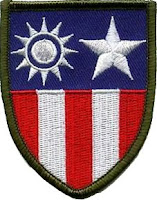Earlier, I was thinking to post a blog on another set of Army booklets which would have served to renew the booklet series but then I thought perhaps it will be too much of literature stuff. As, last couple of blogs have been covering leaflets already.
So for a change, lets go back to miniature creative items :D i.e. stamps/labels. Today's item is focused on labels issued by another princely state: Sangli.
Sangli, was one of the 11-gun salute princely state of British India, under the Kolhapur-Deccan Residency in the Bombay Presidency, and later the Deccan States Agency. It was one of the southern Maratha Jagirs. Its territory was widely scattered among other native states and British districts. Prior to coming into British fold, Sangli was part of Maratha Empire.
Capt. HH Shrimant Raja Saheb Sir Chintamanrao II Dhundirajrao Appsaheb Patwardhan, 3rd Rao of Sangli (later Raja), [what a name, phew!! no offence meant to Raja ji] born 14th February 1890 and succeeded 1901, on attaining his majority in or about 1909, was given full ruling powers by Captain Birk (who was appointed by the Sangli Durbaar as the administrator during the Ruler's adolesence). The Raja ji ruled during WWI & WWII and later led the state in Dominion of India on March 8, 1948.
Sangli is now part of Maharashtra state and is largest trading centre for turmeric; Raisin (Kishmish) in Asia. The green city is also called 'Sugar Belt' of Maharashtra.
Enough of history!! ;-) Let's go back to part which we are really interested in. As we all know, none of princely states used to get 11/21 or even single gun of salute under British Empire unless they had done some service for the Empire. Sangli was no different.
The Raja ji was granted a permanent salute of 9-guns in recognition of war services 1st January 1918 during WWI. Later, he was upgraded to a personal salute of 11-guns together with the style of His Highness 3rd June 1927, and the hereditary title of Raja 1st June 1932.
Sangli continued to support British Empire in all the causes including WWII. Sangli helped in raising funds for RAF sqaudrons by issuing different colorful labels during WWII period.

Shown above is one of such label issued during WWII to encourage people to buy such lables and help the R.A.F. It shows God Ganesha on right hand side while left side of same label depicts Planes circling Sangli palace. Exact date/year of issue is unknown.
 This is another of such label. Good part of this label is that atleast it mentions year of publication 1941 on it. Besides that, the pattern of label is more or less same though there are variations such as palace is replaced by some industrial factories.
This is another of such label. Good part of this label is that atleast it mentions year of publication 1941 on it. Besides that, the pattern of label is more or less same though there are variations such as palace is replaced by some industrial factories.I have this label affixed on one of court paper along with other Sangli Revenue stamps. The court paper also mentions year 1941. The best part I like about these labels are that they are so colorful and there are varities in it. Even though, very little is known about these. I have not found so far any book/catalogues which list Sangli war fund labels.
I'll really appreciate if someone can provide me details if s/he has any on these. In fact, I am willing to buy more of such labels if some collector has spare to offer :-)

















